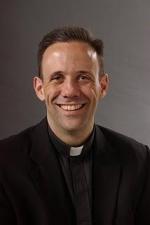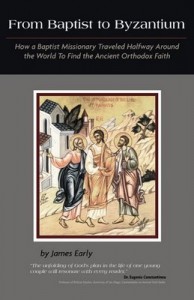An Interview with Fr. James Early
 Originally posted on the Byzantine Texas blogsite, this interview is an excellent introduction to Fr. James’ story and conversion, which we will be publishing shortly in serial format here at JTO!
Originally posted on the Byzantine Texas blogsite, this interview is an excellent introduction to Fr. James’ story and conversion, which we will be publishing shortly in serial format here at JTO!
What prompted you to write the book?
First, several people who had heard me tell my conversion story suggested that I write a book about it, since my story is so unusual. I resisted for quite some time, but finally decided to give in!
Second, I had always been frustrated by (usually due to lack of time) not being able to completely explain the various reasons why my wife and I chose to convert to Orthodoxy. There were so many factors that figured into our decision that a five or ten minute explanation just didn’t do the story justice. Now, when someone asks,
“Now just WHY did you convert to Orthodoxy?”
I can hand them a copy of my book, and they will get a full explanation (assuming, of course, that they actually read it!).Third, I wanted to provide a brief introduction to Orthodoxy–really a case for why someone (particularly a Baptist or other Evangelical) should give Orthodoxy serious consideration. Of course, there are already several excellent books that do this very well, but most are either somewhat long, incomplete, or not irenic in tone. My goal was to cover most of the pertinent concerns that Evangelicals might have about Orthodoxy, but succinctly and in a respectful tone. I tried to make the book very personal, walking them through the discoveries I made, rather than heavily didactic.
Were there any surprises along the way?
I had wanted to write about my pilgrimage to Orthodoxy for quite some time, but unfortunately, writing is one of my least favorite things to do. So, for years, I procrastinated. Finally, in March of 2007, I decided to write a little bit at a time on my blog that I had just started. I had thought that the story might take 10 or 15 posts on the blog. It ended up taking 30, which was my first surprise. Even though I tried to not go into great detail, there was still much to talk about. The series took me about 6 months to complete, because I didn’t have time to write every day.
After the series on the blog was done, I compiled the 30 posts into a single document, and formatted it to look like a book. It came out to 60 pages, double-spaced. Just for the heck of it, I sent it to Frank Schaeffer, the head of Regina Orthodox Press and asked him what he thought. I thought maybe it could be a small book or a beefy pamphlet. He said he liked the story, but it needed to be about twice as long. So, over the next 6 months, I gradually added more material. In particular, I heavily augmented the part about the reasons why I converted.
Finally, I ended up with about 120 pages, and Frank said he would definitely publish it (this was a very pleasant surprise!). It was originally supposed to come out in the Fall of 2008. For various reasons, however, it was delayed twice, finally being published in July of this year. The delays were unfortunate surprises, but in the long run they don’t matter. It’s finally out, and for this I rejoice.
Where do you see this book in the larger category of convert writings? Who did you have in mind reading this book?
I see it as similar to books like Becoming Orthodox by Fr. Peter Gillquist, The Way by Clark Carlton, and Thirsting for God by Matthew Gallatin (all of which were very helpful to me). I designed it to cover more topics than Becoming Orthodox and The Way but to go into less detail on each topic. My book is certainly less detailed than Thirsting for God. And like all three of these excellent books, I include quite a bit of my personal story prior to becoming Orthodox. Particularly, I have included some stories of our adventures and misadventures on the mission field, which I think makes my book unique among convert writings. My book, then, is part adventure story and part apologetic for Orthodoxy.
In other words, if books like Becoming Orthodox and Thirsting for God are “Level one” books for inquirers, mine might be considered “Level zero,” or an introduction to the introductions! If someone reads my book and says, “I want to learn more!”, then I have accomplished my main goal in writing it.
My hope is that the book could be given by an Orthodox believer to a non-Orthodox friend or loved one and that it would be helpful for them, whether or not they are asking about Orthodoxy. I pray that it will be instrumental for many in helping them find their way into Orthodoxy, or at the very least to help them gain an understanding and appreciation of the Ancient Faith.
For those who are already Orthodox, I hope it will confirm them in their faith and provide them with an interesting read.
You are in the midst of doing book signings at parishes in Texas. How have people responded to your book at those functions or even more generally what sort of conversations have you had with people about the book?
People have responded very well and have been very generous in supporting me and the book. Several people have purchased multiple copies and have sent them to friends of various religious affiliations. One of the most common things people say to me is “I have a friend who is a Baptist (or another type of Evangelical). I’ve got to give them a copy!” Another thing that I heard often from cradle Orthodox is (in essence): “Those of us who have been Orthodox all our lives have no idea of what you converts have had to go through just to find your way to the faith. Books like yours help us to not take the faith of our ancestors for granted!” Hearing this has been a real blessing to me.
During your time in Eastern Europe you put a lot of effort into learning the local language. Has your knowledge of Serbian been of service to you as a priest?
My knowledge of Serbian has been helpful mainly when I have filled in for vacationing priests at local Serbian Orthodox parishes, which I have done a total of about a half dozen times over the last few years. When I do this, I generally do about 25% of the Liturgy in Serbian and the rest in English. It is fun to be able to pull my Serbian language skills off the shelf and use them every now and then. Once when I was serving the Divine Liturgy at St. Sava Serbian Orthodox Church in suburban northwest Houston, a man came up to me after the service and asked (in Serbian) “What part of Serbia are you from? I don’t quite recognize your accent.” Needless to say, I was greatly flattered!
You are the asst. pastor at a very vibrant parish divided rather evenly between “cradle” and convert parishioners. Did experiences you’ve had with catechumens inform some of your topic choices?
Not really; I just tried to tell my story, carefully reconstructing the experiences I had and the thinking processes I went through that led me to change (and pretty quickly at that) from a dedicated Baptist to an on-fire Orthodox Christian.
Having said that, let me agree with you by saying that I am blessed to be in a very vibrant parish filled with fervent believers, both convert and cradle. We have grown from about 40 or so families in 2001 (when I joined) to almost 100 today. We have first-time visitors nearly every Sunday, and our visitors tend to keep coming. Most of them eventually become catechumens and get baptized and/or chrismated. We have had non-stop catechumen classes (and, of course, catechumens to take them!) since at least early 2001. I think that the friendliness of our people, the greatness of our pastor, and the fact that we use 100% English in the Liturgy are a large part of the reason that we have been blessed with such growth and stability.
What is the most most common concept or practice found in Orthodoxy that is difficult for Baptists/Evangelicals to accept or understand? How did you choose to tackle the topic in the book?
 There are several Orthodox doctrines and practices that are hard “pills” to swallow for Southern Baptists and other Evangelicals. For Baptists in particular, infant Baptism is especially problematic; after all, the whole Baptist movement was started by people reacting against the practice of infant Baptism, which reformers like Luther and Calvin carried over from Roman Catholicism. The Orthodox Church’s lack of belief in Sola Scriptura and Sola Fide are also major stumbling blocks for Evangelicals. Other problematic beliefs include the sacraments, the veneration of Mary and the Saints, the use of icons (especially their veneration), and prayers for the dead and prayers to the saints.
There are several Orthodox doctrines and practices that are hard “pills” to swallow for Southern Baptists and other Evangelicals. For Baptists in particular, infant Baptism is especially problematic; after all, the whole Baptist movement was started by people reacting against the practice of infant Baptism, which reformers like Luther and Calvin carried over from Roman Catholicism. The Orthodox Church’s lack of belief in Sola Scriptura and Sola Fide are also major stumbling blocks for Evangelicals. Other problematic beliefs include the sacraments, the veneration of Mary and the Saints, the use of icons (especially their veneration), and prayers for the dead and prayers to the saints.
In my book, I dealt with all these issues in a more or less formulaic way. When discussing each, I would say, in essence,
“Here is what I had always believed, here is what I read and what that author pointed out, and here is why it made sense and I changed my mind on the issue.”
Again, I made it all very personal, adopting a tone of “this is what I discovered and why I found it persuasive” rather than simply “this is the truth” (even though I, of course, believe this as well!).
In passing, I must note that the turning point for me was when I accepted the fact that the Orthodox Church was not just the Christian tradition that in its doctrine and praxis is closest to the New Testament Church, but that it is the New Testament Church. At that point, I still had questions about some issues, such as Mary, prayers to the saints and prayers for the dead. But once I realized that the Orthodox Church is the same Church founded by Jesus and the Apostles, guided throughout the ages by the Holy Spirit, I also decided that I could trust the Church.
If I had a problem with something the Church did or taught, the problem was with me, not with the Church.

Leave a Reply